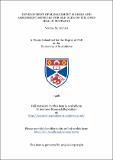Files in this item
Development of management models and assessment methods for red deer on the open hill in Scotland
Item metadata
| dc.contributor.author | Trenkel, Verena M. | |
| dc.coverage.spatial | 194 p. | en_US |
| dc.date.accessioned | 2018-05-29T08:47:49Z | |
| dc.date.available | 2018-05-29T08:47:49Z | |
| dc.date.issued | 1998-08 | |
| dc.identifier.uri | https://hdl.handle.net/10023/13579 | |
| dc.description.abstract | Models to assist the management of red deer on the open hill in Scotland and methods for estimating red deer abundance were studied in this thesis. Currently red deer abundance is assessed by census methods with no estimate of precision. A coefficient of variation of 11-13% was estimated as the precision of repeated census counts on Rum. Misclassification in census counts was studied. Mean relative differences between two simultaneous independent counts were -0.9% (0.16) for stags, -0.5% (0.10) for hinds and 4.4% (0.61) for calves. Numbers in brackets are standard errors. Aerial line transect methodology for estimating deer numbers was tested. Mean estimates were comparable to a census count. In a case study comparison between line transects and census counts the former were shown to be quicker and cheaper for large areas. Past numbers of red deer on the open hill in Scotland estimated by Markov chain Monte Carlo methods, suggested a 30% increase between 1970 and 1992, followed by a small decrease since. Convergence problems lead to reservations about the results. A postal questionnaire survey provided information about current management practices and data availability. An age and sex structured stochastic population dynamics model for red deer was developed incorporating age, sex and density dependent survival rates and weight dependent fertility rates. An updating algorithm was proposed for calibrating the model parameters for any population using only count and cull information for that population. Prior parameter values were obtained from well studied populations. The updating algorithm was based on approximate sequential Bayesian estimation carried out by simulation. Additional features were linear filtering of population estimates and a smoothed bootstrap to generate model parameter estimates. The linear filtering reduced one step ahead prediction errors. The smoothed bootstrap allowed substantial reduction in the number of simulations. For an example red deer population posterior parameter values produced smaller variances of predicted numbers compared to prior parameter values. The calibrated model was used to investigate the effects of alternative culling strategies for a red deer population. | en_US |
| dc.language.iso | en | en_US |
| dc.publisher | University of St Andrews | |
| dc.subject.lcc | SF401.D3T8 | |
| dc.subject.lcsh | Deer | |
| dc.title | Development of management models and assessment methods for red deer on the open hill in Scotland | en_US |
| dc.type | Thesis | en_US |
| dc.type.qualificationlevel | Doctoral | en_US |
| dc.type.qualificationname | PhD Doctor of Philosophy | en_US |
| dc.publisher.institution | The University of St Andrews | en_US |
This item appears in the following Collection(s)
Items in the St Andrews Research Repository are protected by copyright, with all rights reserved, unless otherwise indicated.

